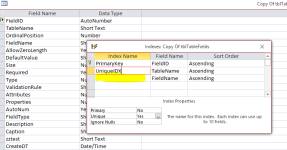stormwaterguru
New member
- Local time
- Today, 02:23
- Joined
- Mar 6, 2025
- Messages
- 12
I think I've seen some advisement to not use calculated fields directly in tables. However, I'd still like to know if there is a way to do the following:
Assign incremental sequential number by Year, i.e. YYYY-DDMM-xxx (xxx being the incremental number within the Year the entry occurs)
The reason I would like to have it calculated in Table is that the data may be imported in rather than interacted with via an Access form.
From what I can tell, DCount would be the way to establish the incremental sequential by year. Being that DCount is not usable in the calculated field of Tables, I don't see a method to do this? It seems like the best I could do is pull date as formatted above and tack on the autonumberID to ensure it remains unique.
Other ideas to execute the ideal formatting seem like they are outside of Table level by utilizing a query or report- would this be correct?
Assign incremental sequential number by Year, i.e. YYYY-DDMM-xxx (xxx being the incremental number within the Year the entry occurs)
The reason I would like to have it calculated in Table is that the data may be imported in rather than interacted with via an Access form.
From what I can tell, DCount would be the way to establish the incremental sequential by year. Being that DCount is not usable in the calculated field of Tables, I don't see a method to do this? It seems like the best I could do is pull date as formatted above and tack on the autonumberID to ensure it remains unique.
Other ideas to execute the ideal formatting seem like they are outside of Table level by utilizing a query or report- would this be correct?

